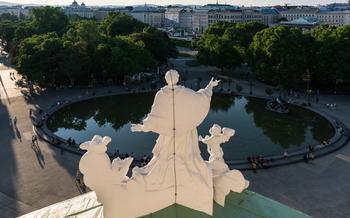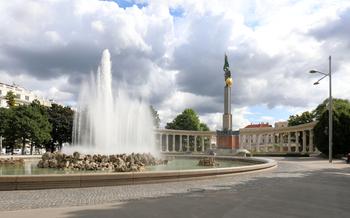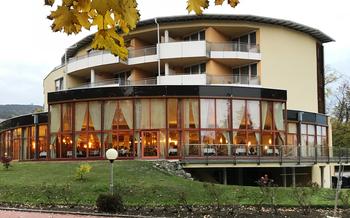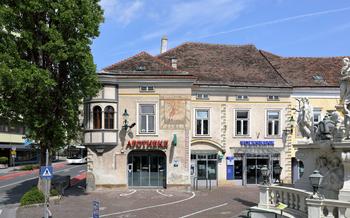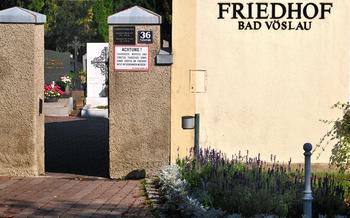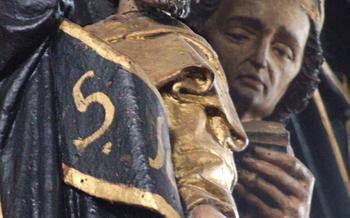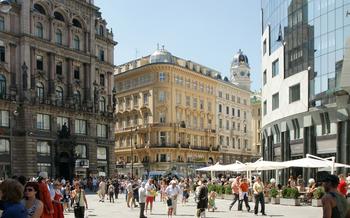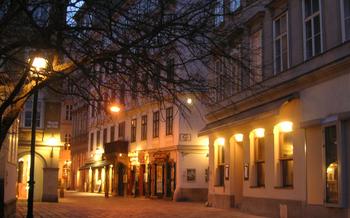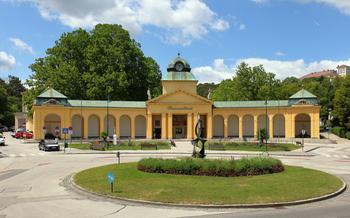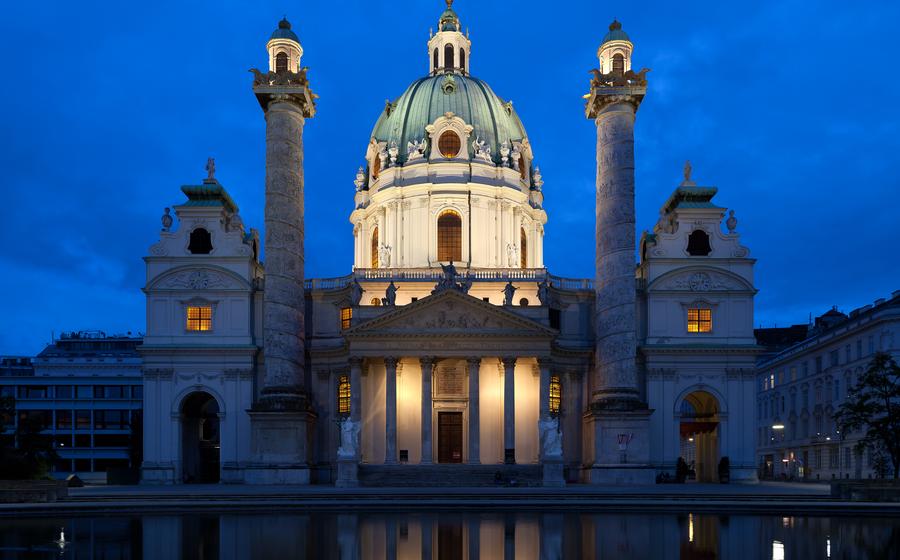
Karlskirche
- The Karlskirche: A Baroque Masterpiece
- The Karlskirche's History
- The Karlskirche's Architecture
- The Karlskirche's Organs:
- The Karlskirche's Crypt
- The Karlskirche's Role in Viennese Culture
- Things to Look for Inside the Karlskirche:
- The Karlskirche's Surroundings: A Tapestry of History and Charm
- The Karlskirche's Legacy
- Events and Festivals at the Karlskirche
- The Karlskirche in Literature and Film
- The Karlskirche and Viennese Music
- Insider Tip:
The Karlskirche: A Baroque Masterpiece
The Karlskirche stands as a testament to the grandeur and artistic prowess of the Baroque period. Commissioned by Emperor Charles VI in 1713 as a symbol of gratitude for ending the plague, this magnificent church has become an iconic landmark of Vienna. The Karlskirche is a masterpiece of Baroque architecture, blending Italian and German influences to create a unique and awe-inspiring structure. Its imposing facade, characterized by twin bell towers and intricate sculptures, immediately captivates the eye. The church's interior is equally impressive, adorned with stunning frescoes, intricate marble work, and opulent altarpieces. The Karlskirche serves as a symbol of Viennese culture and craftsmanship, showcasing the city's rich artistic heritage and enduring legacy.
The Karlskirche's History
In 1713, Emperor Charles VI commissioned the construction of the Karlskirche following a vow he made to St. Charles Borromeo to spare Vienna from a plague outbreak. The church's design was entrusted to Johann Bernhard Fischer von Erlach, one of the most renowned Baroque architects of his time. Construction began in 1716 and continued for over two decades, with the church finally being consecrated in 173
Fischer von Erlach's design for the Karlskirche showcased the grandeur and opulence of the Baroque style, characterized by its elaborate ornamentation, dynamic curves, and dramatic use of light and shadow. The church's construction involved a team of talented artists and craftsmen, including sculptors, painters, and stuccoworkers, who contributed to its magnificent interior and exterior.
Throughout its history, the Karlskirche has hosted significant events such as royal weddings, concerts, and religious ceremonies. It has also witnessed its share of wartime damage, particularly during the Second World War when it sustained significant damage to its roof and dome. The church underwent extensive restoration efforts in the aftermath of the war, which aimed to restore it to its former glory. Today, the Karlskirche stands as a testament to the resilience and enduring beauty of Baroque architecture.
The Karlskirche's Architecture
The Karlskirche is a masterpiece of Baroque architecture, showcasing the grandeur and opulence of the period. Its impressive design is the brainchild of Johann Bernhard Fischer von Erlach, one of the most renowned architects of his time. The exterior is characterized by its towering facade, flanked by two bell towers that rise majestically towards the sky. The facade is adorned with intricate carvings, sculptural reliefs, and statues, depicting saints, angels, and allegorical figures that add to the church's visual splendor.
The interior of the Karlskirche is equally impressive, with its spacious nave, transepts, and apse creating a sense of awe and grandeur. The nave is lined with massive columns topped with intricate capitals, supporting the high vaulted ceiling. The transepts are adorned with elaborate chapels, each dedicated to a different saint. The apse, the most sacred part of the church, is home to the stunning high altar, a masterpiece of sculptural art.
The Karlskirche is a treasure trove of artistic elements, including sculptures, paintings, and frescoes that adorn its interior. The church's ceiling is covered in breathtaking frescoes by the renowned artist Johann Michael Rottmayr, depicting scenes from the life of St. Charles Borromeo and the history of the Catholic Church. The walls are adorned with exquisite paintings by prominent artists, showcasing biblical scenes and the lives of saints.
The Karlskirche's architecture is a testament to the genius of its designers and builders. Its harmonious blend of Baroque elements, intricate details, and artistic masterpieces creates a space that is both awe-inspiring and spiritually uplifting, making it a must-visit destination for anyone interested in architecture, history, and art.
The Karlskirche's Organs:
The Karlskirche is renowned for its impressive organs, which hold significant historical importance in the world of organ building and music performance. These magnificent instruments, crafted by renowned organ builders Gottfried Silbermann and Johann David Sieber, are a testament to the church's dedication to musical excellence.
The main organ, located in the west gallery, is a masterpiece of Baroque organ design. With its 4,978 pipes, it is one of the largest organs in Austria and boasts a remarkable range of stops and sounds. The second organ, situated in the south gallery, is slightly smaller but equally impressive, with 2,531 pipes.
Throughout history, the Karlskirche's organs have attracted renowned organists from around the world, including Anton Bruckner, Franz Liszt, and Maurice Duruflé. These virtuosos have graced the church with their performances, filling its majestic interior with the captivating sounds of organ music.
Regular concerts are held at the Karlskirche, allowing visitors to experience the exceptional acoustics of the church and witness the talents of skilled organists. These concerts showcase a wide repertoire of classical and contemporary organ music, providing a unique and immersive musical experience.
The organs of the Karlskirche are not merely musical instruments; they are works of art in their own right. Their intricate carvings, decorative elements, and gilded pipes add to the church's overall splendor and serve as a testament to the artistry and craftsmanship of their creators.
The Karlskirche's Crypt
The Karlskirche's crypt, located beneath the main church, is a solemn and atmospheric space that serves as a resting place for prominent figures from Vienna's history. Originally intended as a burial site for the imperial family, the crypt is adorned with elaborate sarcophagi and memorials that showcase the artistic and funerary traditions of the time.
Among the notable individuals buried in the Karlskirche's crypt are Prince Eugene of Savoy, a renowned military commander and patron of the arts, and his niece, Princess Maria Josepha of Saxony, who was known for her charitable work. The crypt also holds the remains of several archbishops of Vienna and other distinguished members of the clergy.
The sarcophagi and memorials in the crypt are works of art in their own right, featuring intricate carvings, sculptures, and inscriptions. They serve as a reminder of the lives and contributions of those buried here, as well as the rich history of the Karlskirche and the city of Vienna.
Visitors to the Karlskirche's crypt can experience a sense of awe and reverence as they walk among the tombs of these important figures. The atmosphere is one of quiet reflection, inviting visitors to contemplate the lives of those who have passed and the enduring legacy of the Karlskirche.
The Karlskirche's Role in Viennese Culture
The Karlskirche holds a significant place in Viennese culture, serving as a spiritual and cultural landmark for the city. Its religious significance as a place of worship and pilgrimage for Catholics is evident in the numerous masses, prayers, and processions held within its walls. Beyond its religious role, the Karlskirche is a vibrant center for cultural events, hosting concerts, exhibitions, and festivals throughout the year. These events showcase a diverse range of artistic expressions, from classical music performances to contemporary art exhibitions, attracting both locals and tourists alike.
The Karlskirche has become a symbol of Vienna, representing its rich history, architectural heritage, and cultural significance. Its distinctive silhouette, with its towering dome and twin bell towers, is instantly recognizable and has been featured in countless postcards, paintings, and photographs. The church's unique blend of Baroque architecture and artistic masterpieces has made it a popular destination for visitors from around the world, who come to admire its beauty and learn about its history.
The Karlskirche has also inspired artists, musicians, and writers throughout history. Its grandeur and symbolism have served as a muse for poets, painters, and composers alike. The church's interior has been depicted in artworks by renowned artists such as Johann Martin Schmidt and Johann Baptist Reiter. Its musical heritage includes performances by celebrated composers and musicians, including Wolfgang Amadeus Mozart and Joseph Haydn. The Karlskirche's cultural influence extends beyond its physical presence, as it has become an enduring symbol of Vienna's artistic and cultural achievements.
Things to Look for Inside the Karlskirche:
As you wander through the Karlskirche, keep an eye out for its many artistic masterpieces. Don't miss the stunning frescoes by Johann Michael Rottmayr adorning the dome, depicting scenes from the life of St. Charles Borromeo. In the side chapels, marvel at the intricate altarpieces and sculptures, each telling a unique story from the Bible or the life of the saint.
Look for hidden symbols and meanings in the church's iconography. The Karlskirche is filled with symbolism, from the number 7 (representing the seven gifts of the Holy Spirit) to the various representations of bees, which symbolize diligence and wisdom.
Finally, don't forget to check out the interactive elements within the church. Visitors can climb the stairs to the viewing platform at the top of the dome for panoramic views of Vienna. There's also an audio guide available, which provides fascinating insights into the church's history and architecture.
The Karlskirche's Surroundings: A Tapestry of History and Charm
The Karlskirche is not just a standalone architectural marvel but is also surrounded by a vibrant and historically rich neighborhood. Visitors can embark on a journey of exploration, discovering hidden gems and immersing themselves in the cultural tapestry that surrounds this iconic church.
Just a short stroll away lies the Belvedere Palace, a magnificent Baroque complex that houses the Belvedere Museum. This museum boasts an impressive collection of Austrian art, including masterpieces by Gustav Klimt. The palace's stunning gardens, adorned with sculptures and fountains, offer a tranquil oasis amidst the urban landscape.
For those seeking a taste of Viennese culinary delights, the Naschmarkt, Vienna's largest and most famous market, is within easy reach. Here, visitors can savor a culinary journey through Austria and beyond, sampling everything from fresh produce and artisan cheeses to exotic spices and international cuisine.
The Karlskirche's neighborhood is also home to several charming parks and gardens. The Stadtpark, with its elegant rose gardens and the iconic statue of Johann Strauss II, provides a serene escape from the city's hustle and bustle. The Botanischer Garten Wien, the University of Vienna's botanical garden, offers a tranquil haven filled with diverse plant life from around the world.
Exploring the Karlskirche's surroundings is an essential part of experiencing this architectural masterpiece fully. Whether seeking artistic treasures, culinary delights, or a moment of tranquility in nature, visitors will find a wealth of experiences to enrich their visit.
The Karlskirche's Legacy
The Karlskirche has left an indelible mark on the architectural landscape and cultural heritage of Vienna. Its distinctive Baroque design has influenced numerous buildings and architectural movements, both in Austria and beyond. The church's unique fusion of religious and artistic elements has made it a symbol of Viennese culture, embodying the city's rich history and artistic traditions.
In recognition of its outstanding universal value, the Karlskirche was inscribed on the UNESCO World Heritage List in 200This prestigious designation highlights the church's significance as a cultural monument of global importance, ensuring its preservation and protection for future generations.
Ongoing efforts are underway to maintain and restore the Karlskirche to its former glory. Regular maintenance and conservation projects are carried out to address the effects of time and environmental factors. Skilled artisans and craftsmen work meticulously to preserve the church's intricate details, ensuring that this architectural masterpiece continues to inspire and awe visitors for centuries to come.
Events and Festivals at the Karlskirche
The Karlskirche is not just a stunning architectural masterpiece; it also serves as a vibrant cultural hub hosting a variety of events and festivals throughout the year. From sacred concerts to art exhibitions, there's always something happening at this iconic Viennese landmark.
Regular events include classical music concerts showcasing the talents of renowned musicians and ensembles. The church's exceptional acoustics make it an ideal venue for these performances, creating an immersive and unforgettable musical experience.
Special occasions, such as papal visits or historical commemorations, also grace the Karlskirche's calendar. These events often draw large crowds and offer a unique opportunity to witness the church's grandeur and significance in Viennese history.
To ensure a seamless experience, visitors are encouraged to book tickets in advance for events and concerts. Information on upcoming events, ticket prices, and booking procedures can be found on the Karlskirche's official website or through authorized ticketing platforms.
When attending events at the Karlskirche, it's advisable to dress appropriately, as the church maintains a formal dress code for certain occasions. Seating arrangements vary depending on the event, so arriving early is recommended to secure a preferred seat and fully immerse oneself in the cultural offerings of this magnificent Viennese landmark.
The Karlskirche in Literature and Film
The Karlskirche's grandeur and historical significance have inspired numerous literary and cinematic works, cementing its place in popular culture. In "The Third Man", a classic 1949 film noir set in post-war Vienna, the church serves as a backdrop for a dramatic chase scene. Its imposing facade and intricate sculptures create a visually striking setting that amplifies the film's suspenseful atmosphere.
In literature, Stefan Zweig's "The World of Yesterday" vividly describes the church's role in Viennese society, capturing its spiritual and cultural significance during the early 20th century. The church's grand interior and elaborate ornamentation provide a backdrop for the novel's exploration of Vienna's rich history and the social and political upheavals of the time.
The Karlskirche's captivating presence has also graced the pages of "Vienna: An Opera in Four Acts" by the renowned Austrian writer Heimito von Doderer. In this epic novel, the church serves as a symbol of the city's enduring spirit amidst the tumultuous events of the 20th century.
Beyond its literary and cinematic appearances, the Karlskirche has also inspired musicians and composers. Wolfgang Amadeus Mozart's "Missa Solemnis" was premiered in the church in 1783, showcasing the composer's genius and the church's exceptional acoustics.
The Karlskirche's multifaceted cultural significance continues to attract visitors from around the world, who come to admire its architectural beauty, explore its rich history, and experience its enduring legacy as a symbol of Viennese culture.
The Karlskirche and Viennese Music
The Karlskirche has a strong connection to music, particularly classical music. The church's magnificent acoustics and impressive organs make it a sought-after venue for concerts and performances. Throughout history, renowned musicians and composers have graced the Karlskirche with their talents, leaving an indelible mark on its musical legacy.
One of the highlights of the Karlskirche's musical offerings is the regular organ recitals. The church's two grand organs, with their intricate design and powerful sound, create an awe-inspiring musical experience. Organists from around the world come to perform at the Karlskirche, showcasing their virtuosity and interpreting the works of great composers such as Bach, Handel, and Mozart.
The Karlskirche has also hosted numerous concerts by renowned orchestras and ensembles. The Vienna Philharmonic Orchestra, one of the world's leading orchestras, has performed at the church on several occasions, captivating audiences with their interpretations of classical masterpieces. Other notable musicians who have performed at the Karlskirche include the Vienna Boys' Choir, the Vienna Symphony Orchestra, and the Mozarteum Orchestra Salzburg.
The combination of the Karlskirche's stunning architecture, exceptional acoustics, and rich musical history creates a truly unique and unforgettable experience for music lovers. Attending a concert or organ recital at the Karlskirche is a must for anyone visiting Vienna and seeking a profound musical encounter.
Insider Tip:
-
Best time to visit: For the most serene experience, visit the Karlskirche early in the morning or late in the afternoon to avoid the crowds. The morning light beautifully illuminates the church's exterior, while the evening light casts a warm glow on its facade.
-
Hidden gem: Explore the crypt beneath the church to discover the elaborate sarcophagi and memorials of prominent figures from Viennese history.
-
Photo opportunities: Capture stunning photos of the Karlskirche from the nearby Resselpark, which offers a picturesque view of the church framed by lush greenery.
-
Local recommendations: Indulge in Viennese delicacies at the nearby Café Jelinek, renowned for its delicious pastries and traditional Austrian cuisine.
